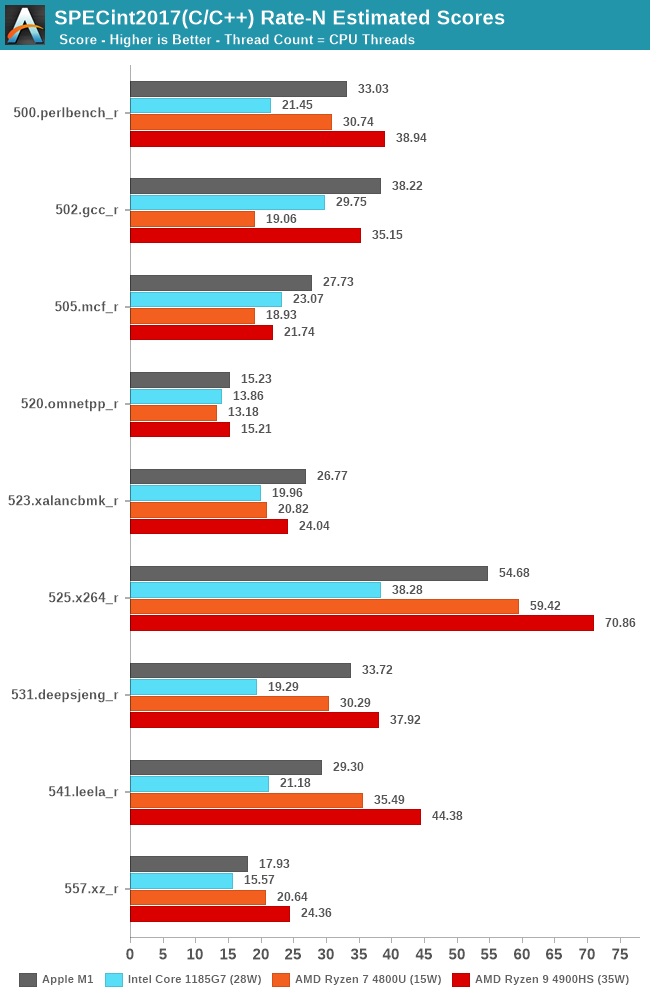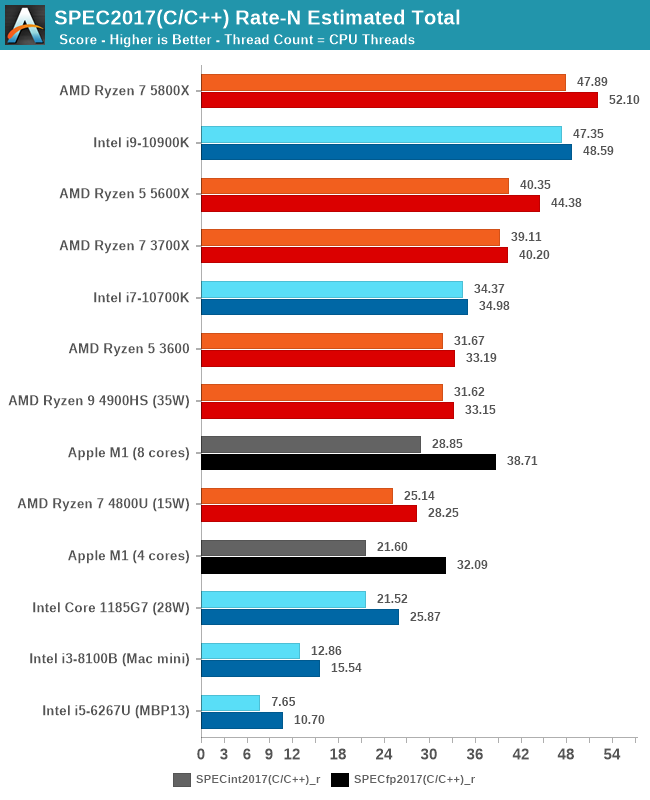The 2020 Mac Mini Unleashed: Putting Apple Silicon M1 To The Test
by Andrei Frumusanu on November 17, 2020 9:00 AM ESTSPEC2017 - Multi-Core Performance
While we knew that the Apple M1 would do extremely well in single-threaded performance, the design’s strengths are also in its power-efficiency which should directly translate to exceptionally good multi-threaded performance in power limited designs. We noted that although Apple doesn’t really publish any TDP figure, we estimate that the M1 here in the Mac mini behaves like a 20-24W TDP chip.
We’re including Intel’s newest Tiger Lake system with an i7-1185G7 at 28W, an AMD Ryzen 7 4800U at 15W, and a Ryzen 9 4900HS at 35W as comparison points. It’s to be noted that the actual power consumption of these devices should exceed that of their advertised TDPs, as it doesn’t account for DRAM or VRMs.

In SPECint2017 rate, the Apple M1 battles with AMD’s chipsets, with the results differing depending on the workload, sometimes winning, sometimes losing.

In the fp2017 rate results, we see similar results, with the Apple M1 battling it out with AMD’s higher-end laptop chip, able to beat the lower TDP part and clearly stay ahead of Intel’s design.

In the overall multi-core scores, the Apple M1 is extremely impressive. On integer workloads, it still seems that AMD’s more recent Renoir-based designs beat the M1 in performance, but only in the integer workloads and at a notably higher TDP and power consumption.
Apple’s lead against Intel’s Tiger Lake SoC at 28W here is indisputable, and shows the reason as to why Apple chose to abandon their long-term silicon partner of 15 years. The M1 not only beats the best Intel has to offer in this market-segment, but does so at less power.
I also included multi-threaded scores of the M1 when ignoring the 4 efficiency cores of the system. Here although it’s an “8-core” design, the heterogeneous nature of the CPUs means that performance is lop-sided towards the big cores. That doesn’t mean that the efficiency cores are absolutely weak: Using them still increases total throughput by 20-33%, depending on the workload, favouring compute-heavy tasks.
Overall, Apple doesn’t just deliver a viable silicon alternative to AMD and Intel, but actually something that’s well outperforms them both in absolute performance as well as power efficiency. Naturally, in higher power-level, higher-core count systems, the M1 can’t keep up to AMD and Intel designs, but that’s something Apple likely will want to address with subsequent designs in that category over the next 2 years.










682 Comments
View All Comments
Spunjji - Monday, November 23, 2020 - link
@Kangal - I have a few disagreements with what you've written here.Firstly, I'm a little confused about why you see the Rosetta-based benchmarks as most relevant. I doubt that anyone buying an M1 device today will be getting rid of it before the majority of apps are converted across, so that performance is going to become increasingly *less* relevant as time passes.
Secondly, this quote: "In short, Apple played it safe and didn't really do their best. That means they purposely left performance on the table, it was artificial and it was deliberate." - I just don't see how you could draw that conclusion. They used their highest-performing cores in the largest chip yet produced on 5nm. It would be bizarre for them to begin such a grand experiment from the top-down - it would produce an odd situation where their most demanding users, who are most likely to be using applications that currently need translation, would be expected to transition to an incomplete ecosystem with performance that doesn't exceed existing systems.
To me, it makes perfect sense from both an engineering and a product perspective. They begin the transition with a relatively small (and thus high-yielding, despite the new process) chip as part of a platform for users who are relatively performance-insensitive, but who will still appreciate the immediate benefits of reduced heat and increased battery life.
I'm also a bit confused about your perspective on their GPU. AFAIK the most modern low-profile low-power GPU out there is Nvidia's 1650 - and in terms of performance-per-watt, this iGPU thrashes it, with absolute performance being not far behind. Perf/Watt appears to be Apple's primary concern (for a given degree of absolute performance), so I see it as a resounding (and surprising) success. It's down to AMD and Nvidia to respond now.
Kangal - Wednesday, November 25, 2020 - link
@SpunjjiThanks for the read, sorry it's quite long.
I mean, the Apple Silicon M1 as it is, it's very good for the new Macbook Air. I guess for the cheap/budget Mac Mini it is also decent. However, it's kind of out of place on the Pro. Perhaps they will launch more Macs in the next 6 months, something beefy for their larger MacBook Pro, and maybe something desktop-worthy in an iMac and Mac Pro. I completely agree with your points. Apple now has the best chipset in the world, their large cores are highly competitive, and their GPU tech is the most efficient. In fact, their medium-cores are the best, they're an Out-of-order processor which sucks slightly less power than a Cortex A53 (or slightly more than A55 ?), but they're slightly faster than a Cortex A73 (or slightly slower than A72 ?). Either way, that's stupidly impressive.
But as it stands, Apple has done the works but on the last yard, pulled its punches.... and I state that since they're saving money on the SoC by sourcing it themselves, and not paying those exorbitant Intel prices. So there's definitely (money and silicon) budget there to go more ambitious. I just wanted to see more competitive/better product segmentation, eg:
Apple M10, ~10W, 8 large cores, 8cu GPU... for 11in laptop, ultra thin, fanless
Apple M13, ~15W, 8 large cores, 16cu GPU... for 14in laptop, thin, active cooled
Apple M15, ~25W, 8 large cores, 32cu GPU... for 17in laptop, thick, active cooled
Apple M17, ~45W, 16 large cores, 32cu GPU... for 29in iMac, thick, AC power
Apple M19, ~95W, 16 large cores, 64cu GPU.... for Mac Pro, desktop, strong cooling
...and after 1.5 years, they can move unto the next refined architecture/node (ex Apple M20, M23, M25, M27, M29 etc etc).
Sherlock - Monday, November 30, 2020 - link
I believe the iPad Pros (if not all iPads) will move to the M1 chip and run the MacOS with the ability to run iPadOS/iOS Apps. With the detachable keyboards and Apple Pen support - they will become the ultimate Portable workstation. Knowing Apple's penchant for a limited product line - they may even drop the Apple Macbook Air.BushLin - Saturday, November 21, 2020 - link
"To be honest, a lot of comparisons of the Apple Silicon M1 are vague, misrepresentative or blatantly off..."<proceeds to list unattributed benchmark results with incorrect power labels>
Spunjji - Thursday, November 19, 2020 - link
@vlad24 - I'm aware of how process node can affect voltage requirements and power draw, and the various TDP differences.I wasn't arguing that TSMC 5nm wouldn't help AMD's power efficiency, I was arguing with the nonsensical statement that it's the *sole reason* for Apple's good showing in that area. lilmoe's salty opinions aren't supported by the facts.
You're correct that AMD at 5nm would probably regain an advantage over M1 in mobile devices, but that will be in a year's time, and Apple aren't standing still. It's likely we'll be seeing them leapfrog each other. In the meantime, it'll be interesting to see how competitive Cezanne ends up being with M1 and/or whatever Apple's next-largest chip will end up being.
vlad42 - Saturday, November 21, 2020 - link
But if shrinking Zen 3 to the same 5nm process would make its mobile variant more energy efficient, then that would imply that Zen 3 is a more efficient architecture. It just happens that the architecture is held back in this specific comparison by the manufacturing process.We do not know if AMD will bother to port Zen 3 to 5nm, they could skip straight to Zen 4. Who knows what process Apple will be using by the time AMD moves to 5nm. 3nm could still be too expensive for chips larger than those used for phones.
Granted if the energy efficiency of Zen 3 equals M1 when both are on 5nm, then the M1's efficiency cannot be solely due to 5nm unless that were also true for Zen 3.
mdriftmeyer - Saturday, November 21, 2020 - link
Zen 4 is scheduled to have samples Q1 2021 on 5nm advanced node TSMC. The fact you don't know this tells me you don't follow AMD.Spunjji - Monday, November 23, 2020 - link
@mdriftmeyer - You'd be wrong in both assuming that I don't know and that I don't "follow AMD". Samples in Q1 2021 does not equal released product in Q1 2021, does it? I'm talking about product availability, and you're moving the goalposts for reasons that aren't clear to me.magreen - Tuesday, November 24, 2020 - link
@Spunjji - Thanks for your insightful responses, as usual. Sometimes I'm tempted to just hit Ctrl-F to find your comments and ignore the rest.haghands - Tuesday, November 17, 2020 - link
Cope